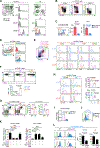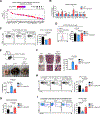Integrin CD103 expression in naive CD8+ T cells promotes cytokine-driven acquisition of memory phenotype and effector function
- PMID: 40957420
- PMCID: PMC12441315
- DOI: 10.1016/j.immuni.2025.08.014
Integrin CD103 expression in naive CD8+ T cells promotes cytokine-driven acquisition of memory phenotype and effector function
Abstract
Integrin CD103 binds to E-cadherin, a cell adhesion molecule predominantly expressed on epithelial cells, thus mediating the tissue residency of CD103+ T cells in barrier sites. Importantly, circulating naive CD8+ T cells also express large amounts of CD103, but whether CD103 contributes to CD8+ T cell immunity beyond its role in cell adhesion is unclear. Here, we report that CD103 expression in naive CD8+ T cells facilitates their engagement with E-cadherin-expressing cells, promoting their acquisition of memory phenotype and effector function. Notably, dendritic cell (DC) subsets expressing E-cadherin and producing type I interferons and interleukin-12 (IL-12) were responsible for this process. As a corollary, the DC-specific loss of E-cadherin resulted in diminished effector CD8+ T cell differentiation and increased tumor susceptibility, while the forced expression of CD103 enhanced the effector functions and anti-tumor activity of CD8+ T cells, revealing a regulatory role for CD103 in cytotoxic T cell immunity.
Keywords: E-cadherin; IFN-β; IL-12; IL-15; dendritic cells.
Published by Elsevier Inc.
Conflict of interest statement
Declaration of interests The authors declare no competing interests.
Figures







References
-
- Quinn KM, Fox A, Harland KL, Russ BE, Li J, Nguyen THO, Loh L, Olshanksy M, Naeem H, Tsyganov K, et al. (2018). Age-Related Decline in Primary CD8(+) T Cell Responses Is Associated with the Development of Senescence in Virtual Memory CD8(+) T Cells. Cell Rep 23, 3512–3524. 10.1016/j.celrep.2018.05.057. - DOI - PubMed
-
- Haluszczak C, Akue AD, Hamilton SE, Johnson LD, Pujanauski L, Teodorovic L, Jameson SC, and Kedl RM (2009). The antigen-specific CD8+ T cell repertoire in unimmunized mice includes memory phenotype cells bearing markers of homeostatic expansion. J Exp Med 206, 435–448. 10.1084/jem.20081829. - DOI - PMC - PubMed
MeSH terms
Substances
Grants and funding
LinkOut - more resources
Full Text Sources
Molecular Biology Databases
Research Materials

